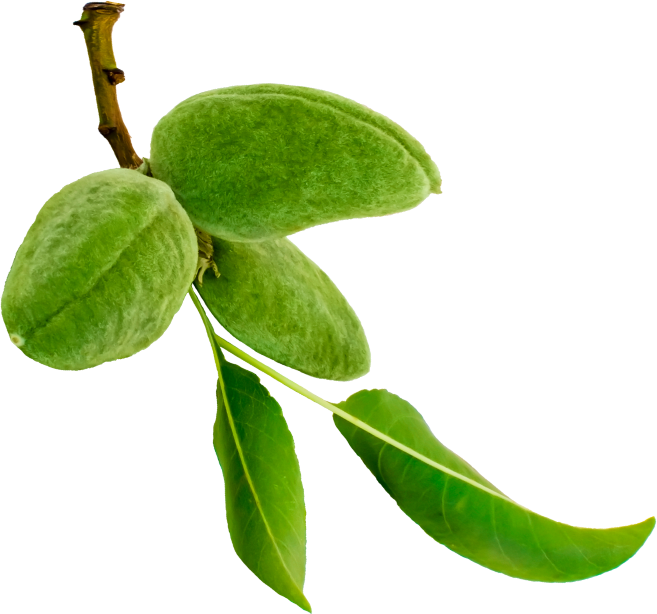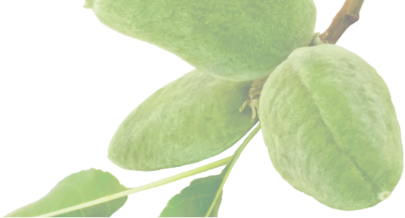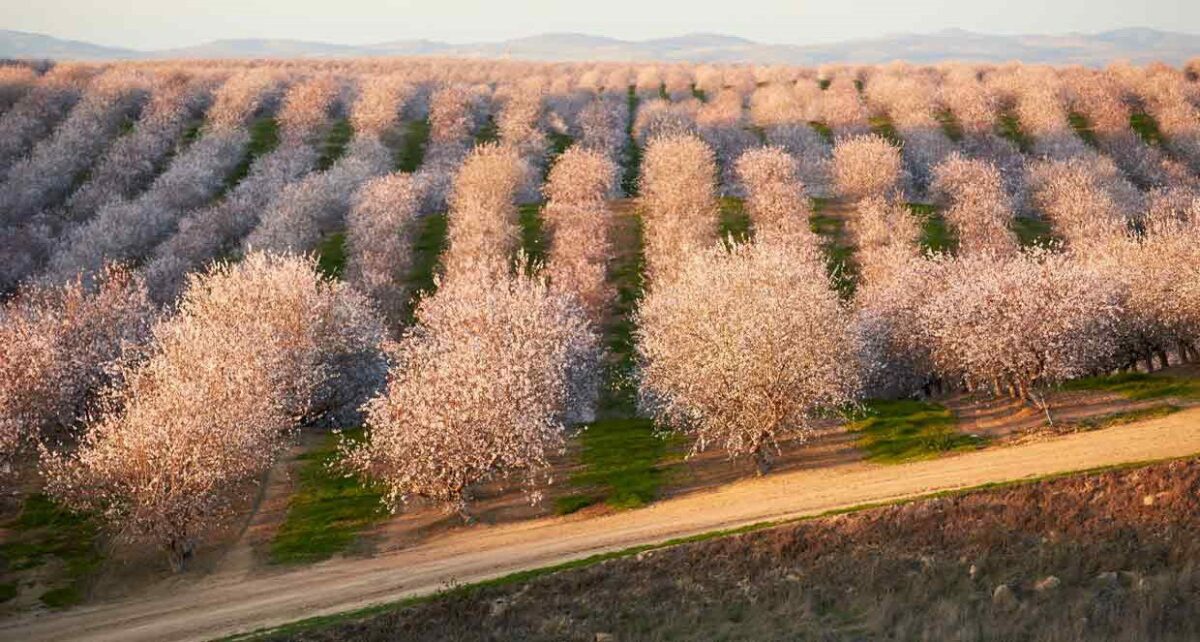Almond Orchard Basics
Considered one of the best healthy snacks and a versatile ingredient, almonds offer consumers and manufacturers delicious access to healthy fats, vitamins, proteins, and essential minerals for diet and product development goals. Almond products are ideal as the base or complement in a host of dishes, both sweet and savory. However, almonds don’t appear fully formed and ready to consume, they must be carefully grown and harvested in an almond orchard before being processed for consumption or ingredient utilization.
The Almond Tree
At the core of an almond tree lies the root system, essential for absorbing water and nutrients from the soil. These nutrients travel upward through the trunk, which serves as the central, sturdy support for the tree.
Extending from the trunk are the branches that bear leaves and eventually host breathtaking blossoms that bloom between mid-February and mid-March. These white or light pink flowers create a picturesque landscape and are important for attracting pollinators.
After pollination, the blossoms develop into drupes. Drupes grow on the branches of almond trees and are composed of three parts: a green fleshy hull, a shell, and the almond kernel.
These well-known tree nuts are popular around the world, but many are unaware of how many different types of almond trees are out there, thanks to the efforts of evolution, crossbreeding, and research.
First, almonds can be classified into two main categories: sweet almonds (Prunus dulcis, variety dulcis) and bitter almonds (Prunus dulcis, variety amara). Sweet almonds are the more familiar and widely consumed variety, known for their pleasant taste and culinary uses. On the other hand, bitter almonds are less commonly utilized and possess a distinct chemical composition, characterized by elevated levels of amygdalin, benzaldehyde, and prussic acid.
With major advancements in almond breeding and farming, sweet almond trees exist in various varieties, all of which differ in aspects like surface characteristics, applications, and size. You can read more about the different varieties in our Types of Almonds article, but generally, you’ll find Nonpareil, Independence, Monterey and Wood Colony, and California-Type almonds to be commonly found in California almond orchards.
The Orchard
The orchards themselves are set up to maximize space, sunlight, air circulation, water distribution, and efficient management. They are typically planted in rows with clear pathways for farmers and machinery to perform necessary activities such as pruning, irrigation, pest management, and harvesting.
Harvesting Almonds
An almond tree can take three-five years before it starts producing almonds, and a mature tree can continue producing a yield for up to 30 years.
Almond harvests start in late July each year and typically last two to four months. Almond farmers use mechanical shakers to knock the almond crop off of the trees and onto the orchard floor. Once on the ground, these almond hulls are left to dry in the sun for up to ten days. After drying, farmers will sweep them into rows where they are collected and transported to almond processors.
Almond Orchard Management
Almond orchard management presents a set of unique challenges that require diligent attention and expertise. Farmers and orchard managers must navigate these challenges to ensure the health, productivity, and sustainability of their orchards, many of which are family-owned. Some key steps in almond orchard management include:
- Pruning – Pruning branches keep farms from growing at awkward angles, keeping things clean while prioritizing better results in the future. Pruning is essential for the controlled guidance of nutrition during the growing process.
- Crop Protection – Crop protection is challenging yet essential part of almond growing to ensure the health and productivity of an orchard. Pest Control Advisers (PCAs) and pest management tools are key resources for guidance on pest control practices, alternatives to spray, application, and reducing spray drift. These resources help fight against common pests including ants, stink bugs, leaf-footed bugs, and NOW (navel orangeworm). NOW, in particular, is a huge challenge throughout the industry as the primary pest in California that not only damages the not but risks the crop’s food safety. Another recurring aspect of protection is weed management. Identifying, monitoring, and controlling weeds is a major part of maintaining orchards.
- Fertilization – Proper fertilization control is necessary for the long-term vitality of an almond farm. Almond farmers must employ various, complex practices to provide the right balance of nutrients. Key considerations included soil testing, macronutrients, micronutrients, timing and frequency, applications, environmental concerns, and more.
California Almond Stewardship Platform (CASP)
One of the top resources for almond growers and sustainable almond orchard management is the California Almond Stewardship Platform (CASP), led by The Almond Board of California. The CASP platform encourages participation in sustainable growing efforts and builds a network of important almond orchard information.
CASP participants are provided with key data on the almond industry. This includes data on:
- Orchard management practices
- Farm Sustainability Assessment (FSA) via the Sustainable Agriculture Initiative
- Bee Friendly Farming Program in Pollinator Partnership
- Irrigation Continuum by the California Almond Board
- Nitrogen levels for almond crops
- Irrigation schedules for almond orchards
- Irrigated Lands Regulatory Program (ILRP)
- Irrigation and Nitrogen Management Plan (INMP)
- Responsible and efficient almond farming in CA
Tools that are available thanks to CASP include:
- Field mapping tools
- Nitrogen fertilizer calculator
- Irrigation system calculator
- Irrigation and nitrogen management planning
Partnering With An Industry Leading Almond Processor: Harris Woolf Almonds
Founded by almond growers, Harris Woolf Almonds is a leading producer of almonds and almond products with a network of over 200 farms and farmers around California. We are committed to serving the almond farmers and orchards that make up our local economy and environmental landscape.
We promote participation in the online CASP platform to encourage our growers to be a part of industry advancements and have access to valuable information and tools. Currently, about 50% of our grower base has completed the CASP assessment, and our goal is to increase the number to 75% by 2025.
Another aspect of sustainable almond orchards is the implementation of pollinator-friendly farming practices. Currently, about 40% of our grower base is Bee Friendly Farming certified. This means they have planted pollinator habitat in or near their orchards that provides nourishment and nesting habitat; they also use integrated pest management strategies. We aim to increase the percentage of certified acreage to 75% by 2025.
A Look Into Our Growers
Woolf Farming
One of our largest growers, Woolf Farming continues to adopt new technology and farming practices that maximize its product and innovate the agricultural industry. One of the many examples of these strategies is their utilization of effective tracking technologies that reduce the amount of tractor time needed to farm, resulting in higher soil quality and reducing their long-term carbon footprint. They also stand out as pollinator health pioneers with over 200 acres of bee habitat for the year-round conservation of honey bees and pollinators.
Harris Farms
Harris Farms, located in Fresno County, is one of the largest agribusinesses in the nation and has been able to remain under continuous family operation since 1937. The company produces a wide range of products, including almonds, and continues to boost the Harris family’s value and commitment to sustainability.
No matter what orchard, farmer, or almond product, Harris Woolf Almonds offers support, sustainability, and expertise in the almond industry. For more information on our grower network and products, contact us today!

















